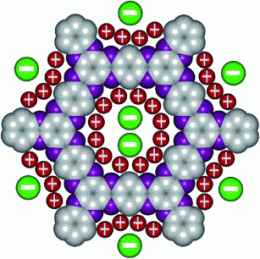New rechargeable batteries needed: A microporous polymer is an unusually powerful supercapacitor

(PhysOrg.com) -- For future electric vehicles, powerful notebook computers, and other portable devices, we need a new generation of energy storage materials that are better suited to modern needs than current rechargeable batteries. The best materials for this are known as supercapacitors. A team led by Dinglin Jiang at the National Institutes of Natural Sciences in Okazaki (Japan) has now introduced a new material with outstanding supercapacitor properties in the journal Angewandte Chemie.
Emission-free electric cars are well suited for drives around the city; for long stretches, however, this has not been the case. The problem stems from the small amount of energy that can be stored, which covers only short distances before requiring a charge, and the amount of current that can be delivered, which limits the speed and acceleration of the vehicles. Supercapacitors could overcome these challenges because they combine the advantages of earlier capacitors and batteries: like a capacitor, they can deliver high current densities on demand while storing a large amount of electric energy like a battery.
Supercapacitors work on a different charge-storage principle than rechargeable batteries, and consist of electrochemical double layers on electrodes, which are wetted by an electrolyte. When a voltage is applied, ions of opposite charge collect on both electrodes to form wafer-thin zones of immobilized charge carriers. In contrast to a battery, there is only a shift of charge; no chemical transformation occurs. Various materials are suitable for supercapacitors, but the truly perfect material has yet to be found. The researchers in Japan have now reached an important milestone along the way.
There is one class of materials with interesting properties: special microporous, framework-like, organic polymers. Their double bonds are arranged in such a way that some of their electrons can move freely over extended regions of the framework as an “electron cloud”. Such materials are thus conducting. A large inner surface area is important for the formation of electrostatic charge-separation layers in the pores. Jiang and his team have now synthesized a nitrogen-containing framework with a pore size optimal for allowing ions to flow in and out rapidly – a requirement for rapid charging and discharging. The nitrogen centers interact with the electrolyte ions, thus favoring the accumulation of charge and the movement of ions.
The interplay between these different advantageous properties provides the new material with an unusually high charge storage capacity and high energy density. Jiang and his co-workers were able to demonstrate that their microporous frameworks can withstand many charge/discharge cycles.
More information: Donglin Jiang, Supercapacitive Energy Storage and Electric Power Supply Using an Aza-Fused π-Conjugated Microporous Framework, Angewandte Chemie International Edition, dx.doi.org/10.1002/anie.201103493
Provided by Wiley



















